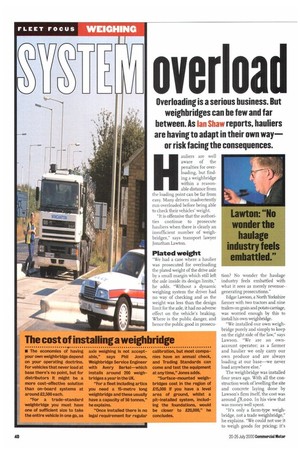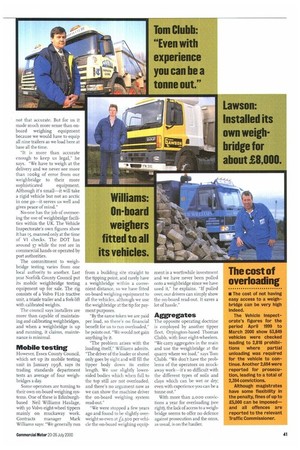aware of the penalties for overloading, but finding a weighbridge
Page 42

Page 43

If you've noticed an error in this article please click here to report it so we can fix it.
within a reasonable distance from the loading point can be far from easy. Many drivers inadvertently run overloaded before being able to check their vehicles weight.
"It is offensive that the authorities continue to prosecute hauliers when there is clearly an insufficient number of weighbridges," says transport lawyer Jonathan Lawton.
Plated weight
"We had a case where a haulier was prosecuted for overloading the plated weight of the drive axle by a small margin which still left the axle inside its design limits," he adds. "Without a dynamic weighing system the driver had no way of checking and as the weight was less than the design limit for the axle, it had no adverse effect on the vehicle's braking. Where is the public danger, and Hence the public good in prosecw
tion? No wonder the haulage industry feels embattled with what it sees as merely revenue• generating prosecutions."
Edgar Lawson, a North Yorkshire farmer with two tractors and nine trailers on grain and potato carriage, was worried enough by this to install his own weighbridge.
"We installed our own weighbridge purely and simply to keep on the right side of the law," says Lawson. "We are an ownaccount operator; as a farmer and haulier we only carry our own produce and are always loading at our base—we never load anywhere else."
The weighbridge was installed four years ago. With all the construction work of levelling the site and concrete laying done by Lawson's firm itself, the cost was around £8,000. In his view that was money well spent.
"It's only a farm-type weighbridge, not a trade weighbridge," he explains. "We could not use it to weigh goods for pricing; it's not that accurate. But for us it made much more sense than onboard weighing equipment because we would have to equip all nine trailers as we load here at base all the time.
It is more than accurate enough to keep us legal," he says. "We have to weigh at the delivery and we never see more than rookg of error from our weighbridge to their more sophisticated equipment. Although its small—it will take a rigid vehicle but not an arctic in one go—it serves us well and gives peace of mind."
No-one has the job of overseeing the use of weighbridge facilities within the UK. The Vehicle Inspectorate's own figures show it has I5, manned only at the time of VI checks. The DOT has around 37 while the rest are in commercial hands or operated by port authorities.
The commitment to weighbridge testing varies from one local authority to another. Last year Norfolk County Council put its mobile weighbridge testing equipment up for sale. The rig consists of a Volvo aro tractive unit, a triaxle trailer and a fork-lift with calibrated weights.
The council says installers are more than capable of maintaining and calibrating weighbridges, and when a weighbridge is up and running, it claims, maintenance is minimal.
Mobile testing
However, Essex County Council, which set up its mobile testing unit in January 199S, says its trading standards department tests an average of four weighbridges a day.
Some operators are turning to their own on-board weighing systems. One of these is Edinburghbased Neil Williams Haulage, with 30 Volvo eight-wheel tippers mainly on muckaway work. Contracts manager Mark Williams says: "We generally run from a building site straight to the tipping point, and rarely have a weighbridge within a convenient distance, so we have fitted on-board weighing equipment to all the vehicles, although we use the weighbridge at the tip for payment purposes.
By the same token we are paid per load, so there's no financial benefit for us to run overloaded," he points out. We would not gain anything by it.
The problem arises with the loading itself," Williams admits. -The driver of the loader or shovel only goes by sight and will fill the tipper body down its entire length. We use slightly lowersided bodies which when full to the top still are not overloaded, and there's no argument now as we can show the machine driver the on-board weighing system read-out."
"We were stopped a few years ago and found to be slightly overweight so even at f2,5oo per vehicle the on-board weighing equip ment is a worthwhile investment and we have never been pulled onto a weighbridge since we have used it," he explains. "If pulled over, our drivers can simply show the on-board read-out. It saves a lot of hassle."
Aggregates
The opposite operating doctrine is employed by another tipper fleet, Orpington-based Thomas Clubb, with four eight-wheelers. "We carry aggregates in the main and use the weighbridge at the quarry where we load," says Tom Clubb. "We don't have the problems of the operators on muckaway work—it's so difficult with the different types of soils and clays which can be wet or dry: even with experience you can be a tonne out."
With more than 2,000 convictions a year for overloading (see right), the lack of access to aweighbridge seems to offer no defence against prosecution and the onus. as usual, is on the haulier.




















































































































